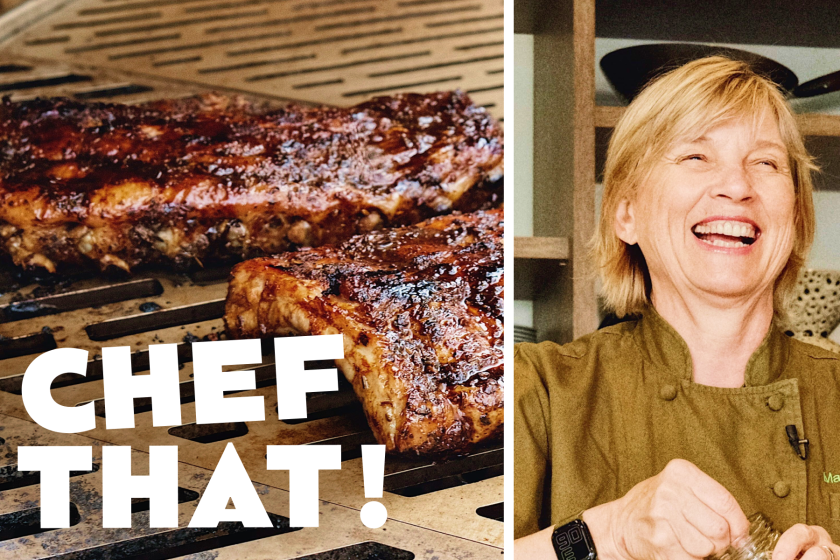As demand for government relief grows, L.A. restaurants form a united front
The push to organize began in earnest early last week with two meetings: one held at the Atwater Village pizzeria Hail Mary, the other a conference call organized by Ann Hsing, chief operating officer of Santa Monica restaurants Pasjoli and Dialogue.
A few days earlier, Mayor Eric Garcetti had ordered dine-in service suspended at Los Angeles restaurants to curtail the spread of the novel coronavirus. The directive effectively shut down thousands of sit-down restaurants. With revenue from takeout and delivery unlikely to keep businesses afloat, a handful of chef, owners, and other restaurants workers gathered to assess the situation.
“Originally it was just a forum for chefs and owners to express their concerns, share knowledge, get everyone on the same page because we’re all reeling,” said Kristel Arabian, a former chef and owner of the hospitality recruitment company Kitchen Culture Recruiting who attended the meeting at Hail Mary. “We talked about rent concerns, taking care of employee payroll, business interruption insurance.”
Arabian said the attendees realized that a centralized hub of communication was badly needed, a place where workers could easily share info and available resources.
Afterward, Arabian and Konbi chef-owner Akira Akuto launched @cahospitalitycoalition, an Instagram account that provides links to resources for employees and organized early efforts to contact lawmakers about a restaurant relief bill.
The duo reached out to nearly everyone they knew to spread the word, expanding what began as a loose affiliation of Eastside restaurants into a network of a few thousand people in two days.
Meanwhile, Hsing gathered a group of roughly 120 restaurant operators on the Westside to share info and resources among restaurants struggling to figure out how to cover employee health care or negotiate with landlords. An open letter to Gov. Gavin Newsom asking for financial relief for restaurants was drafted and widely distributed, and later folded into the California Hospitality Coalition’s social media account.
“At this point, we will definitely take a Band-Aid for a gunshot wound. I know it’s not going to solve everything, but at least I can put it on until the ambulance arrives.”
— Kristel Arabian, California Hospitality Coalition
Arabian and Hsing soon realized that similar restaurant coalitions were popping up in Seattle, San Francisco, Chicago and New York. A larger coalition began to form.
“On Saturday I had so many calls with so many different people and so many groups, it was hard to keep track of who was who,” Arabian said. “By Sunday, though, it felt like everyone was forming bridges and getting on track together.”
The newly united front, at least in L.A., emphasized outreach at three levels: city, state and federal.
Eddie Navarrette, a longtime restaurant design and construction consultant, used his contacts with the Los Angeles planning department to connect with local officials. Others drafted letters to state representatives about extending unemployment benefits for laid-off or furloughed workers. A restaurant advocacy group at the federal level called the Independent Restaurant Coalition, backed by chefs including Tom Colicchio, Marcus Samuelsson and Naomi Pomeroy, advocated for a large-scale “income-replacement program” that would cover restaurant workers and rent costs for at least six months.
Akuto said that although federal action is important, focusing on city and state is more vital in the near future. “We can’t wait two months or four months or whenever help from the Senate bill might arrive,” he said. “Right now the city and the state have been most effective in getting our employees covered, which is the main concern.”
As coalitions combine resources and scramble to figure out assigned roles, Arabian insists that the larger goal is not to speak on behalf of every restaurant but to make sure concerns and issues are communicated in ways that have the most effect.
“We’re trying to put everything under one banner, in an open-source way, because that is what makes it easy to share the message,” she said. “There’s a majority of opinion of what needs to be done and what our industry needs help with. We’re trying to make the big movements on behalf of small businesses.”
Akuto said the industry’s most dangerous enemy at this point is inaction.
“Every day that help is stalled, it gets exponentially worse. There’s no way to quantify it. No one can wrap their head around a trillion dollars, they just need actual money to give their staff so that people can have lives,” he said. “In cities like Paris and London, restaurants are shutting down completely because they know the government will provide health care for the workers or will help offset their expenses. We don’t have that here.”
Arabian said that last week was a flurry of action — she worked 16-hours days as information flooded in — but this week has been empty and scary. The Los Angeles City Council delayed its meetings for two weeks, which means a longer lag until potential relief arrives.
On the California Hospitality Coalition Instagram account, Arabian has turned to posting tips on mental health and links to charity groups feeding undocumented workers.
“We’re trying to push any content that can help workers,” Arabian said. For her, that means connecting people to places where they can donate or assist with causes that are immediate and actionable, and that help get essentials like groceries to people who need them now.
As for what lies ahead, Akuto says he’s prepared for the worst. “It’s a war for survival, basically. Because most businesses are not going to make it. It’s deteriorating to a situation none of us have ever seen before.”
Over the last few days, Arabian said, more people have become aware of the restaurant world’s specific crisis. “I get that other industries are hurting right now, but most of them don’t involve millions of employees and 8% of the GDP. Most of them don’t survive on a 5% to 10% profit during normal times. It’s not just restaurants, it’s bars, bakeries, coffee shops. Everyone is suffering,” she said.
“At this point, we will definitely take a Band-Aid for a gunshot wound. I know it’s not going to solve everything, but at least I can put it on until the ambulance arrives.”
Until then, thousands of restaurant operators are doing what they can to find any semblance of a solution for themselves and their workers — negotiating with landlords, insurers and vendors, and jamming the inboxes of every elected official who will listen. Any success, no matter how trivial, will be passed along the communication chain in the hope that it will help another business survive.
“We’re not only doing this as owners, we’re trying to cover everyone under the umbrella — dishwashers, servers, cooks, everyone,” Akuto said. “That’s how to get through this.”
“People who work in restaurants, they’re so used to fighting for survival,” Arabian said. “We don’t want to come across as desperate or broadcast how dire things actually are. … [But] restaurants are shutting down for good. They can’t support their employees. There’s a shame that comes with saying that, but word needs to get out that this is happening.”
More to Read
Eat your way across L.A.
Get our weekly Tasting Notes newsletter for reviews, news and more.
You may occasionally receive promotional content from the Los Angeles Times.










